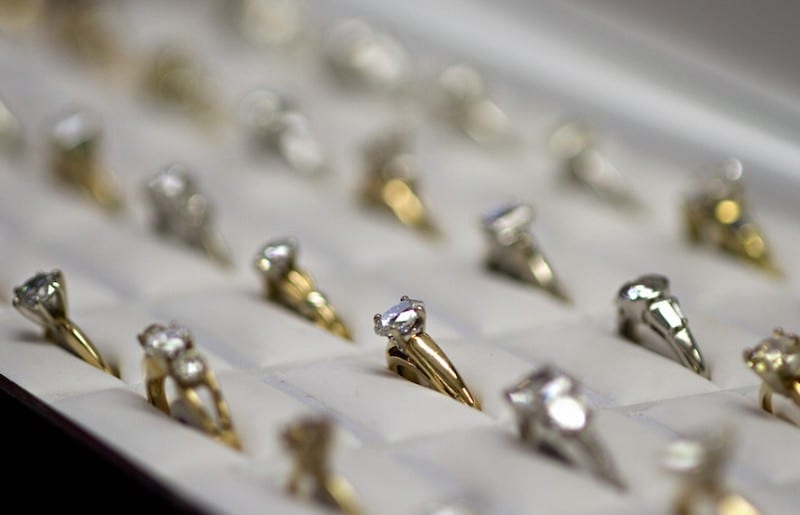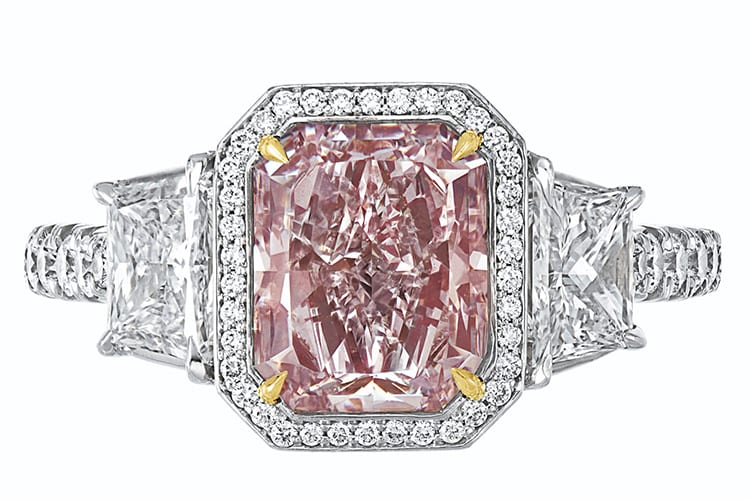
To million have any hope of understanding diamonds, knowing “The Four C’s” is as important as knowing a new car’s horsepower, fuel efficiency, and safety ratings. This is the start (but not the end) of evaluating a diamond. The Four C’s—cut, color, clarity, and carat—are the criteria by which diamonds are graded. The system was developed by the Gemological Institute of America (GIA) and adopted by the entire industry.
The Four C’s are based on a diamond’s rarity: the rarer the C (not necessarily the “prettier”) the more the C contributes to the diamond’s price. The Four C’s are completely independent of each other. For example, a diamond can have high color but a low clarity, or high clarity but a low cut, etc. So unless you know all of the Four C’s, it’s impossible to compare one diamond to another.
Cut
Cut represents 50% of the price of a diamond. A full cut diamond has 57 or 58 facets (cuts). Think of facets as mirrors. If the facets are positioned properly, light enters the diamond, bounces across the various facets, and eventually leaves at the viewer’s eye. If a single facet is not positioned properly, light leaks out of the diamond, never maximizing fire, sparkle, or brilliance, and never reaching its full optical potential. The better the diamond cut, the rarer the diamond, the more expensive the diamond. The GIA cut grades are poor, fair, good, very good, excellent.
Bigger isn’t always better. Look for super sparkle at sites like White Flash and Brian Gavin. Both are known as go-to sellers of ideal cut diamonds.

Color
Diamonds are over 95% comprised of carbon. Other minerals get trapped in the diamond when it’s forming. Often these trace elements will alter the color of the diamond. When nitrogen is trapped in the diamond, the diamond begins to turn yellow. The color scale is from D-Z. As you go from D-Z, there is more nitrogen present, the diamond becomes more yellow, the diamond is less rare, and therefore costs less money.

Clarity
Most often, we see traces of the natural growth process in the finished diamond product. These characteristics are called blemishes or inclusions. Blemishes are characteristics such as scratches that are confined to the surface of a diamond. Inclusions (trapped minerals, breaks, growth marks), however, are either totally confined to the inside of a diamond, or they start inside a diamond and break through its surface. The clarity scale ranges from Flawless to Imperfect.The in-between grades assess how apparent the inclusions are when viewed under 10X magnification. The fewer inclusions, the rarer the diamond, the more expensive the diamond.

FL- Flawless: No blemishes or inclusions when examined by a skilled grader using 10X magnification.
Bottom line: Color grade affects price. You can see it with your own eyes at James Allen , where you can literally spin the diamond around 360 degrees.
IF- Internally Flawless: No inclusions—and only insignificant blemishes—when examined by a skilled grader using 10X magnification.
VVS1, VVS2 – Very, Very Slightly Included: Minute inclusions that are difficult for even a skilled grader to locate under 10X magnification.
VS1, VS2 – Very Slightly Included: Minor inclusions ranging from difficult to somewhat easy for a trainer grader to see under 10X.
SI1, SI2 – Slightly Included: Noticeable inclusions which are easy—or very easy—to see under 10X. In some instances, even, inclusions can be spotted with the unaided eye.
I1, I2, I3 – Included: Inclusions which are obvious to a trained grader under 10X magnification, can often be seen face up with the unaided eye, and could potentially affect durability or beauty.
Imperfect: obvious inclusions when viewed under 10X magnification.
Carat
Carat refers to the weight of a diamond. 1 Carat (Ct) weighs 1/5th of a gram. 1 Carat can be divided into 100 points, just as $1 can be divided into 100 cents. Therefore, 1/2 carat equals 50 points, 1/4 carat weighs 25 points and so on. The more a diamond weighs, the rarer the diamond, the more expensive.

Phew! We know, we know, that’s about the dryest, most boring article you will ever find on The Plunge. Or anywhere. If you can tolerate a little more pain, click here for your next lesson.
Bottom line: You get more sparkle for less dough at James Allen’s and Blue Nile


















